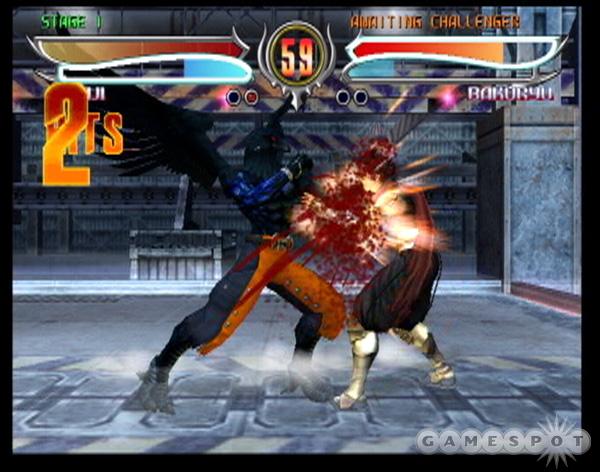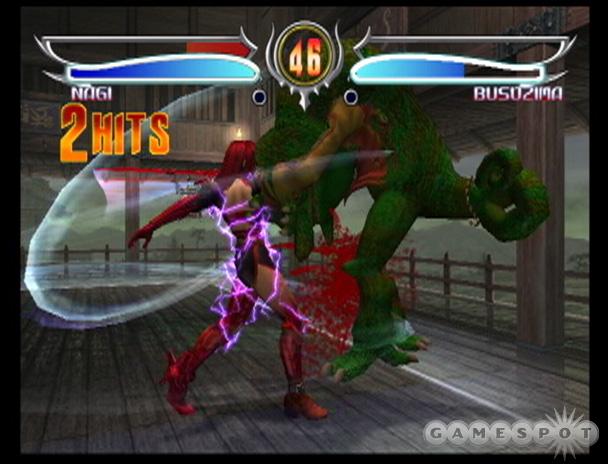Despite its title, Bloody Roar 4 is actually the sixth in Hudson's series of 3D fighting games, which originally debuted way back in 1997. The most recent entries include this year's Bloody Roar Extreme for the Xbox and last year's Bloody Roar: Primal Fury for the GameCube, whereas Bloody Roar 4 brings it back home to a Sony platform. If you've played any Bloody Roar game from over the years, on any game system, then you'll basically know what to expect from this latest installment. It features the same sort of simple, fast-paced, good-looking action that's enabled this series to squeak by for all these years, but the addition of a few new fighters, a new mode, and some tweaks to the gameplay don't stop this from being a rather simple, shallow game.

At a glance, the Bloody Roar games do nothing to distinguish themselves from better-known 3D fighting game series, like Virtua Fighter, Tekken, and Dead or Alive. This new game features 18 different characters, who mostly look like a bunch of hipsters who'd be more at home in a dance club than in a fighting arena. The vast majority of these characters return from previous Bloody Roars, and one thing both the old and new characters have in common is their ability to change forms. That's always been Bloody Roar's twist. In battle, characters can instantly shed their human skin (it actually all happens in a white flash) to become an anthropomorphic animal or some other creature. Werewolves, weretigers, werelions, wererabbits, werebeetles, wereiguanas, and more can be found in this game, and when the fighters are in their transformed state, they're capable of longer-ranged, more-damaging moves than usual. Strangely, the designers seem to have run out of animal ideas, as many of the newer Bloody Roar characters have demonic rather than animal forms. Nagi, the new female character depicted on the cover of the game, turns into sort of a succubus rather than, say, a Chihuahua.
OK, maybe all the viable giant-animal ideas have already been used up. But, really, that's part of the problem. Apart from the characters' transformation abilities, which they can use from the first moment of any match at the press of a button, the fighters in Bloody Roar 4 are capable of the sorts of things you'd expect to see in any off-the-wall fighting game. Fast, simple combos reward button mashing, as each fighter can easily string together punches and kicks for some pretty big damage. Some moves launch opponents into the air, and you may continue to juggle them on their way down with still more attacks. Strings of a half-dozen or more hits are common. Some countermoves and guard-crushing moves are available, respectively, for dealing with opponents who are too reckless or too defensive. But these are par for the course in the genre and are rarely worth the risk when the alternative is to keep churning out quick, easy, damaging combos. Mechanically, the game works well. The controls are responsive, and the action, for the most part, is fast and smooth. The average fighting-game player with any level of proficiency should be able to see through this game's limited strategies and moves list relatively quickly. As any long-running fighting game series tends to, Bloody Roar does have its own modest following, and these players should appreciate some of the nuanced changes to the gameplay, if for no other reason than that they're nuances.
Of course, Bloody Roar 4 does have some new features that distinguish it from its predecessors. Here are the obvious ones. Several new characters are available, including the previously mentioned Nagi. There's a lanky guy named Reiji who turns into a big crow. There's also Ryoho and his sidekick Mana. He's a burly monk, and she's his companion--a little girl who turns into a fox. You control Ryoho directly, and Mana has a few moves of her own to execute while in fox form. Bloody Roar 4 offers a standard selection of modes of play, but the main new addition is the strangely named "career mode," in which you can choose a character and work your way through a gridlike map. It's all completely abstract, and it's really no different than the arcade mode--though it does tack-on an experience point system. Each place on the map pits you up against another character (with most of these battles featuring just one round), and winning battles earns you DNA points, which can be used to equip your characters with certain new moves and abilities. Over the course of this career mode, you can develop a significantly overpowered character, but since the battles against the wimpy computer-controlled opponents are a total cakewalk from the outset, there isn't much incentive to build such a juggernaut. The career mode feels pretty underdeveloped, overall.
Bloody Roar 4 also packs some gameplay tweaks, the most notable of which is the fact that characters now have two life bars--one for their human form and one for their beast form. The round doesn't end until both life bars are depleted, so if you lose all your health in human form, you instantly change to beast form. Your beast form health regenerates as you deal or take damage in human form, which means that you should switch to beast form as often as possible to try to avoid any "permanent" damage. All this is a strange dynamic that's not necessarily an improvement over previous Bloody Roars, in which you could only stay in beast form for a limited amount of time. Now it's possible for rounds to stretch on for a while if both players play it really safe in human form. On the other hand, a few quick flurries in beast form can end a round in seconds. Actually, some of the characters with stronger beast forms become quite overpowered as a result of this change. At the beginning of a match, they can immediately unleash their strongest attacks.

The arcade mode of Bloody Roar 4 lets you fight through one opponent after another until you reach the final battle, which is predicated on some completely inane dialogue. The dialogue is all dubbed in English and is poorly translated, but it can be entertaining if for no other reason than its sheer absurdity. The rest of the audio is serviceable but understated and forgettable. As mentioned, the AI in Bloody Roar 4 really doesn't present much of a challenge, though, as a two-player game, it could theoretically be fun for a while. Bloody Roar 4 runs at a very smooth frame rate for the most part, though in some situations there's noticeable, annoying slowdown. The characters look quite good and animate well, and the variety of backgrounds, while predictable, also look good. Most of the returning characters look the same as ever, but one of the strangest new additions to this Bloody Roar is a blood effect, whereby certain moves will cause the character on the receiving end to gush Mortal Kombat-style blood. This must have earned Bloody Roar 4 its "M" for Mature rating, which seems rather ridiculous, actually. The "M" needlessly limits this game's already limited audience, as there's really no graphic violence to be found here--or at least nothing beyond what you can find in any other fighting game.
Bloody Roar 4 is a predictable follow-up to a series that's never aimed particularly high. Fans of fighting games may appreciate it since it does offer more than a dozen different characters to play around with, and some of the character designs are actually pretty appealing. Still, this one can mostly be recommended only to those who really like fighting games, in general, or to those who are looking for a casual, anime-style game to play with like-minded friends.